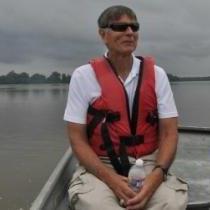
John Davy is a Richmond, Virginia-area outdoor enthusiast who enjoys spending time on the waters of the Chesapeake Bay—be it exploring in kayaks or fishing or tubing from a small powerboat.
Accessing CBIBS data—primarily by using a CBIBS smartphone app because they are “quick and convenient”—helps Davy plan his time outdoors in the Chesapeake watershed. He monitors a number of parameters tracked by CBIBS buoys to see if the day is right for his small-craft adventures.
“The ones I use the most are wind speed, wave height, air temperature, and water temperature. These all play a role in what I plan or can do on a given day. The others I look at just for general interest,” he said.
Davy—who counts the Potomac River, Solomons Island, and Eastern Shore among his most-treasured Chesapeake places—primarily checks observations at the Upper Potomac, Potomac, Jamestown, and First Landing CBIBS buoys.
“My primary place for boating is the lower Potomac off of Colonial Beach. The two Potomac River buoys give me a good indication of what the water is like so I can plan accordingly when I leave Richmond for the river,” he explained. “The James is a place I frequently visit so again I enjoy checking it out before heading that way. First Landing I use any time there is a storm event just to see what the wind and wave heights are doing. It is just fun to see what is happening from the comfort of home!”
Davy has known of and used CBIBS data for quite a while: In a previous job with the Virginia Department of Conservation and Recreation, he was involved in early conversations about the buoy system when it was just a concept being discussed about 10 years ago. Now that the buoy system includes 10 robust observational platforms up and down the Bay, transmitting real-time data 24/7, he thinks it’s great for the public.
“It is a great tool for knowing conditions on the water before you head out. It is also a fun tool when storms or other weather events are moving through the Bay system. For school kids involved in science projects, you can help track water conditions in real time,” he details.
In addition to the CBIBS smartphone app, Davy also checks the National Park Service’s Chesapeake Bay Explorer app to find and get to wonderful places around the Chesapeake Bay. Like the CBIBS app, it is available for both iPhone and Android systems.
Photo of John Davy near Presquile National Wildlife Refuge on the James River courtesy National Park Service.


